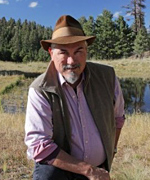 —Alan Dulaney
—Alan Dulaney
“Shade” is an old term signifying a ghostly suggestion of a former living presence. The shade of the Colorado River may wander the Lower Basin for decades, absent real action to shorten demand.
SB 1507 and the shadow House version, HB 2512, have moved out of committee. SB 1507 has passed the Committee of the Whole process and is approaching the Third Read in the Senate. HB 2512 passed out of the House a couple of weeks back. This grand legislative package does absolutely nothing to address the declining water level elevations on Lake Mead. And apparently some unseen presence wants it that way.
It is now increasingly obvious that there is no way to avoid a declared shortage on the Colorado River. Demand continues as it always has. Yet snowfall across the entire Colorado River Basin is much less than the historic annual mean, and warming temperatures produce less useful runoff. Salt River Project is calling this winter the third driest in recorded history — and that is just on the Salt-Verde watershed. Absent a significant reversal of meteorological trends of the last 18 years, streamflow and reservoir storage must inevitably decline. January’s modeling runs by the Bureau of Reclamation for the Lower Colorado River Basin show a 17% probability for declared shortage in 2019, and 49% by 2020. We are playing Russian roulette with half the chambers loaded.
If we look ahead at Arizona’s Colorado River supply for the next few years, and assume that a Tier 1 shortage occurs in 2020, a Tier 2 shortage could occur by 2023. A Tier 3 shortage might occur by 2025 or 2026. This is based on a 10–12 ft/yr drop in Lake Mead water level elevations. Such declines are a response to the constant demands for the water from the Lower Colorado River Basin states. Only a small fraction of this decline is caused by lake evaporation, and that percentage decreases as water levels drop and the lake’s surface area decreases. Demand is the key; if demand does not decline with the declining supply, there is no halting the depletion of Lake Mead.
This is what the Drought Contingency Plan and its Arizona sibling, the DCP Plus, were designed to address. Major reductions in demand shared by all would keep some water flowing to all during a declared shortage. The suffering would be shared amongst the Lower Basin states and Mexico. All the schemes of entities that want to control access to Colorado River water — forbearance, use of excess water, transfers from Mohave County, gaming the system of water levels — will not keep some water flowing to all. We need that water. Without DCP and DCP Plus, Arizona will face a brutally rough awakening when Lake Mead water levels drop to dead pool at elevation 895 feet. This is what the Legislature should have addressed.